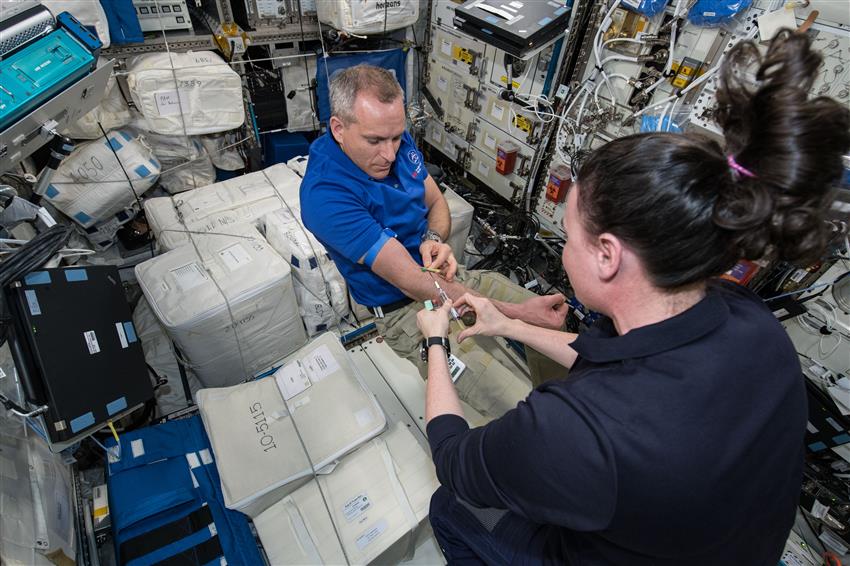MARROW: Keeping blood healthy in space
The Canadian experiment MARROW studied how bone marrow (the spongy tissue inside bones) and the blood cells it produces change in space.
The MARROW experiment was completed in . Read about the results below.
The Canadian experiment MARROW, conducted on the International Space Station, studied how bone marrow (the spongy tissue inside bones) and the blood cells it produces change in space. The study produced interesting results that help us better understand space anemia. (Credits: Canadian Space Agency, NASA, The Ottawa Hospital/University of Ottawa)
Background
It is well known that during a space mission, the hard bones lose calcium and strength, but what happens to the bone marrow had never been measured. Experiments on Earth suggested fat cells in bone marrow may increase, leaving less room for the production of red and white blood cells.
A decrease in red blood cells can produce anemia, whose symptoms include physical limitations such as weakness, persistent fatigue, and slower brain function. With fewer white blood cells, the body becomes more vulnerable to infections and more sensitive to radiation exposure.
Objectives
MARROW aimed to:
- measure fat changes in the bone marrow before and after astronauts spend six months in microgravity
- determine whether the bone marrow changes are reversible
- track specific changes in red and white blood cell function before, during and after spaceflight
Impacts on Earth
MARROW's findings will help understand and monitor the effects of physical inactivity on seniors, bedridden patients, and those with reduced mobility or undergoing rehabilitative treatment.
In fact, Principal Investigator Dr. Guy Trudel hopes to apply the knowledge gained in space to his work at The Ottawa Hospital, where he directs the rehabilitation of patients who have been bedridden for long periods of time, like father and entrepreneur Raymond Nicholas.
How it works
Fourteen astronauts participated in this study.
- Before the astronauts left Earth, researchers used magnetic resonance imaging (MRI) to establish the fat content in their bone marrow.
- The participants also gave blood and breath samples before their flights to assess red and white blood cell function.
- On the ISS, astronauts repeated the same blood and breath samples.
- For up to a year after return, they underwent serial MRI scans. Comparing these images allowed scientists to chart their recovery and track how much fat tissue accumulated in the confined space inside the bones.
- A final set of blood and breath samples were tested and compared.
Results
The MARROW experiment detected the following changes:
- During a six-month mission, astronauts' bodies were destroying 54% more red blood cells than typical preflight rates.
- Five of the 13 astronauts who had their blood drawn shortly after landing back on Earth were anemic. Red blood cell levels gradually improved three to four months post-flight.
- The rate of red blood cell destruction remained 30% higher one year after landing than before missions to the International Space Station.
MARROW's findings suggest that further research is needed to fully understand spaceflight-related anemia. Mitigating strategies, like an adapted diet, may be necessary for crews embarking on longer missions.
Timeline
MARROW began collecting data in and completed its final tests in .
Research team
Principal investigator
- Dr. Guy Trudel, University of Ottawa, Bone and Joint Research Laboratory
Co-investigators and employees
- Dr. Odette Laneuville, University of Ottawa
- Dr. Ian Cameron, The Ottawa Hospital
- Dr. Adnan Sheikh, The Ottawa Hospital
- Dr. Alain Stintzi, University of Ottawa
- Dr. Tim Ramsay, Ottawa Hospital Research Institute
- Hakim Louati, University of Ottawa
- Theresa Backlund, University of Ottawa
- Dr. Paola Sebastiani, Boston University
ESA astronaut Tim Peake took part in the Canadian experiment MARROW, which studied these effects to benefit astronauts and people on Earth who are bedridden or who have reduced mobility. (Credits: Canadian Space Agency, NASA, University of Ottawa)

